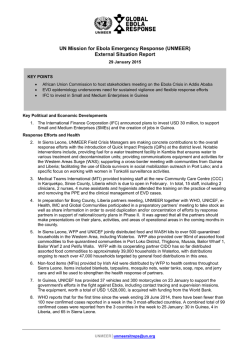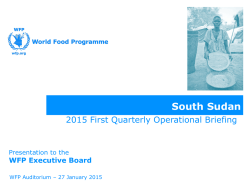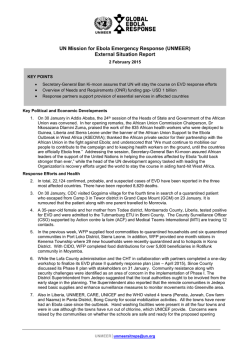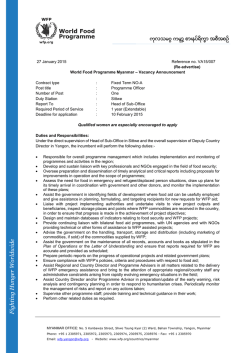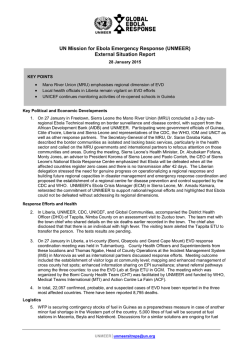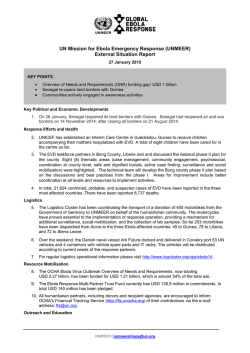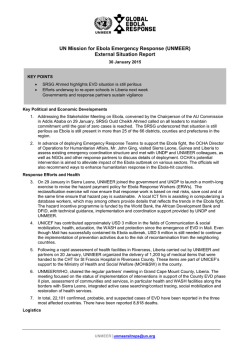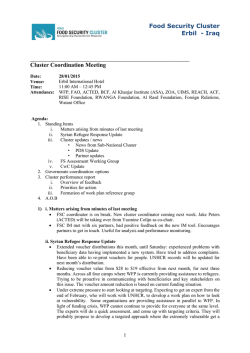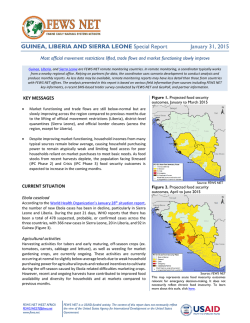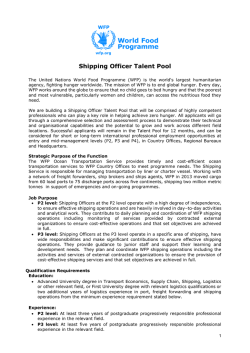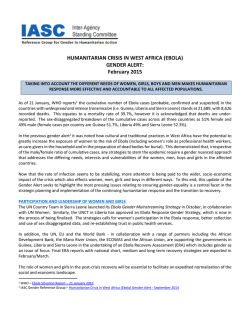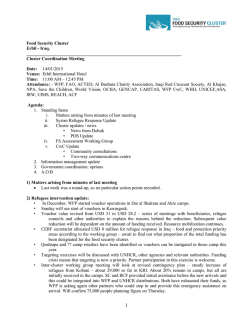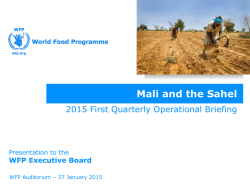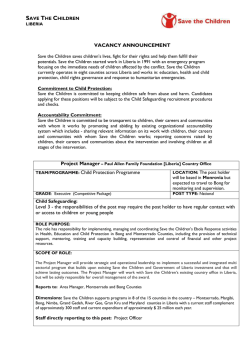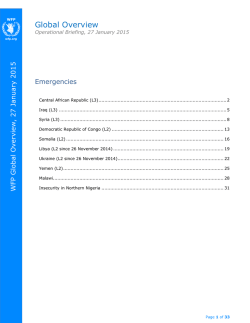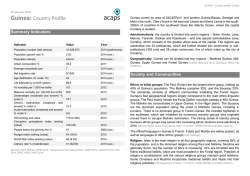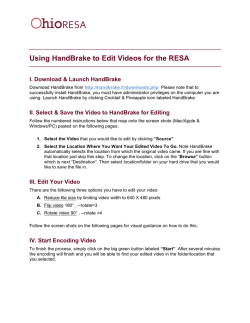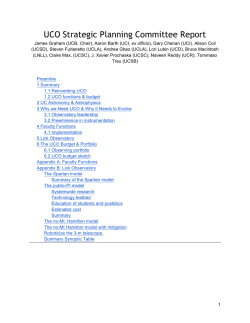
West Africa Ebola Outbreak - WFP Remote Access Secure Services
West Africa Ebola Outbreak 2015 First Quarterly Operational Briefing Presentation to the WFP Executive Board WFP Auditorium – 27 January 2015 Humanitarian Situation • Case incidence is progressively slowing down in all the three countries. As of 22 January 2015, WHO reported a total of 21,759 cases and 8,668 deaths in Guinea, Liberia and Sierra Leone. SITUATIONAL UPDATE • Notwithstanding, transmission continues in all three countries. Epidemiological analyses suggest there are several microoutbreaks, each at different stages and with potential to flare. New hotspots are declared, as geographic pattern of transmission shifts. • The virus has exacerbated existing vulnerabilities the three countries. Formal and informal economic activities have severely contracted. Real-time monitoring underscores that affected communities continue face low wages, reduced demand for labor, and market disruptions. • Meanwhile, basic services have been completely disrupted. Five million children are estimated to be out of school, and could miss up to a full academic year; today, most schools remain closed, and fear and stigma will present a further challenge to timely return of children to schools. Nutrition treatment and services feeding services in the three countries have drastically declined. Security Situation • Tensions are high among the local population in areas of Guinea, resulting in security incidents against health personnel and infrastructure. • Qualitative reports suggest continued skepticism among communities regarding ebola. Traditional burials continue in secret. SITUATIONAL UPDATE Measures to ensure staff safety and well-being: • WFP now has two health advisors per country and field security officers; at the regional level, the structure is overseen by a regional health advisor and senior field security officer, complemented by a public health specialist and staff counselor. To ensure a locally sensitive and durable structure, in-country advisors recruit and mentor national advisors (already 4 recruited). • Helicopters equipped for medical evacuation are now in place for in-country transport of ebola-symptomatic personnel. SITUATIONAL UPDATE MAP: Food Follows the Virus Framework of Interventions Regional EMOP 200761 Support to populations in areas affected by the Ebola outbreak in Guinea, Liberia and Sierra Leone Target: 3 million beneficiaries CARE Treatment PROGRAMMING Survivors Isolated households CONTAIN Areas of intense transmission LICK TO EDIT SUBTITLE Timeline: (25 August 2014 – 31 May 2015) TRANSITION Kick-start local economies in areas formerly of intense transmission Framework of Interventions SO (Regional) 200773 Logistics Common Services for the Humanitarian Community’s Response to the Ebola Virus Disease Outbreak in West Africa Timeline: (15 October 2014 – 31 May 2015) • Aviation support (strategic airlifts of equipment and passenger transport via UNHAS) LICK TO EDIT SUBTITLE PROGRAMMING • Provision of Inter-agency Coordination through the Logistics Cluster • Provision of Telecoms infrastructure through the ET Cluster • Provision of engineering support to health facilities • Emergency preparedness and response measures Operational Priorities 1. Operationalization of latest EMOP and SO budget revisions Refining support to survivors, rolling out cash and vouchers in the three countries, reinforcing nutrition support, and particular attention to introducing the transition pillar. Increasing up-country warehouse, transport and communications capacity where requested, and ensuring reliable and safe transport of staff, equipment, and goods as health response focuses at district-level. LICK TO EDIT SUBTITLE PROGRAMMING 2. Preparing for early recovery Early recovery assessments underway. Working with governments and partners to support safe and gradual rehabilitation and resumption of basic services. 3. Looking beyond Re-conceptualizing livelihood, nutrition and education programmes – integrating short-term priorities into longer-term programmes and leveraging new opportunities. Monitoring mVAM • In Liberia and Sierra Leone the fourth monthly round of data collection on food security is completed, data analysis is ongoing. In Guinea, the fourth round of data collection is ongoing. Sample size has been increased by an average 250 households in each country. • All bulletins and data issued since October are available on the VAM page of WFP website: http://vam.wfp.org/sites/mvam_monitoring/ Monitoring • In Guinea, first round of post-distribution monitoring took place using on the ground questionnaires and focus group discussions; exercise was coordinated with health advisors to mitigate risk. In Liberia and Sierra Leone WFP is testing mobile PDM (mPDM) through mobile phones. LICK TO EDIT SUBTITLE PROGRAMMING • Priority: strengthening output and outcome monitoring. • The logical framework of EMOP was adapted in January to capture project specific outcome indicators, specifically: how food has supported households to reduce unnecessary movements during containment. Next step: define and incorporate questions on socio-anthropological impact of ebola in assessment and monitoring tools. Inter-Agency Coordination UNMEER Sector coordination • Cluster system active in Liberia. In Guinea and Sierra Leone benefit from pre-existing working group structures. LICK TO EDIT SUBTITLE INTER-AGENCY & CLUSTERS • Stronger presence on the ground. Liaison officer now based in Dakar. And UNMEER staff seconded to WFP UNHAS regional team to collaborate on management of UNMEER assets. Early Recovery Assessments (ERAs) • Lead by UNDP. Missions conducted in Guinea, Liberia and Sierra Leone to address the impacts of the ebola crisis on four thematic pillars: Health, Water and Sanitation; Infrastructure and Basic Services; Socio-economic Recovery; Peacebuilding. Implementing Capacity Staff: • 1,053 staff (813 national and 240 international) in the 3 countries WFP Offices: • 1 Regional Bureau + liaison office in Accra • 3 Country Offices • 7 Sub-offices in Guinea • 6 Sub-offices in Liberia • 5 Sub-offices in Sierra Leone LICK TO EDIT SUBTITLE CAPACITY Warehouse network reinforced under SO: • 4 regional Staging areas (Accra, Dakar, Las Palmas, Cologne-Bonn airport) • 3 national staging areas (Conakry, Monrovia, Freetown) • 3 main logistics hubs (Conakry, Monrovia, Port Loko) • 11 Forward Logistics Bases (2 in Guinea, 6 in Liberia, 4 in Sierra Leone) • In addition to set-up of Mobile Storage Units where required by WFP and partners – at “last mile.” Challenges • Moving to « transition » phase alongside continued support to the health response. • High reliance on short-term TDYers. As begin to plan for recovery and longer-term, putting in place a more sustained staffing structure will be critical to prepare the foundations for new programmes. A challenge in context of multiple L3s. • Defining vulnerability criteria that is ebola sensitive as prepare for recovery. LICK TO EDIT SUBTITLE CAPACITY • Countries will require important investment in recovery, and maintain attention in « post-ebola » headlines and sufficient resourcing will be critical. Requirements and Resourcing Needs Confirmed Contributions Shortfall Regional EMOP200761 $189,133,000 $ 132,600,212 30 % Regional SO200773 $178,533,000 $ 130,796,720 27 % LICK TO EDIT SUBTITLE RESOURCING Financial overview of WFP Ebola Response as of 26 January 2015 • Ebola crisis is atypical and conditioned by high rate of uncertainty. Supporting a health emergency means that the entry point for WFP assistance is not the traditional food security criteria. In this context, WFP is not the driver defining the where/who/why. • Unanticipated scale, type and number of requests to WFP common services platform – high expectations and demand on WFP. • The unique and rapidly evolving crisis required that WFP learn and adjust along the way. By maintaining flexibility and adaptability, WFP was able to successfully adapt its traditional tools to support the health response. LICK TO EDIT SUBTITLE RISKS Management review: summary findings Real-time review of risks, opportunities Output: Matrix opportunities and actions NOVEMBER - DECEMBER Management review exercise Output: Documenting challenges and response LICK TO EDIT SUBTITLE Visit of Inspector General DECEMBER - JANUARY Risk analysis Output: Identify residual/new risks and mitigation measures FEBRUARY RISKS Compliance team based in Dakar, travelling to Accra and 3 COs WFP and WHO: the new partnership WHY: Two primary objectives: • Ensure the financial, administrative, communications, procurement, and security support required to enable WHO technical teams to be present and operational at the district and county level; WHAT: LICK TO EDIT SUBTITLE • Learning opportunity to reinforce operational capacities of the agencies to respond to complex health crises in the future. RISKS Provision of operational support to WHO technical field teams at the national, sub-national and field level in the three countries through a scaled-approach in priority areas determined by WHO and governments. HOW: Building teams together with WHO at the national and district level.
© Copyright 2026
